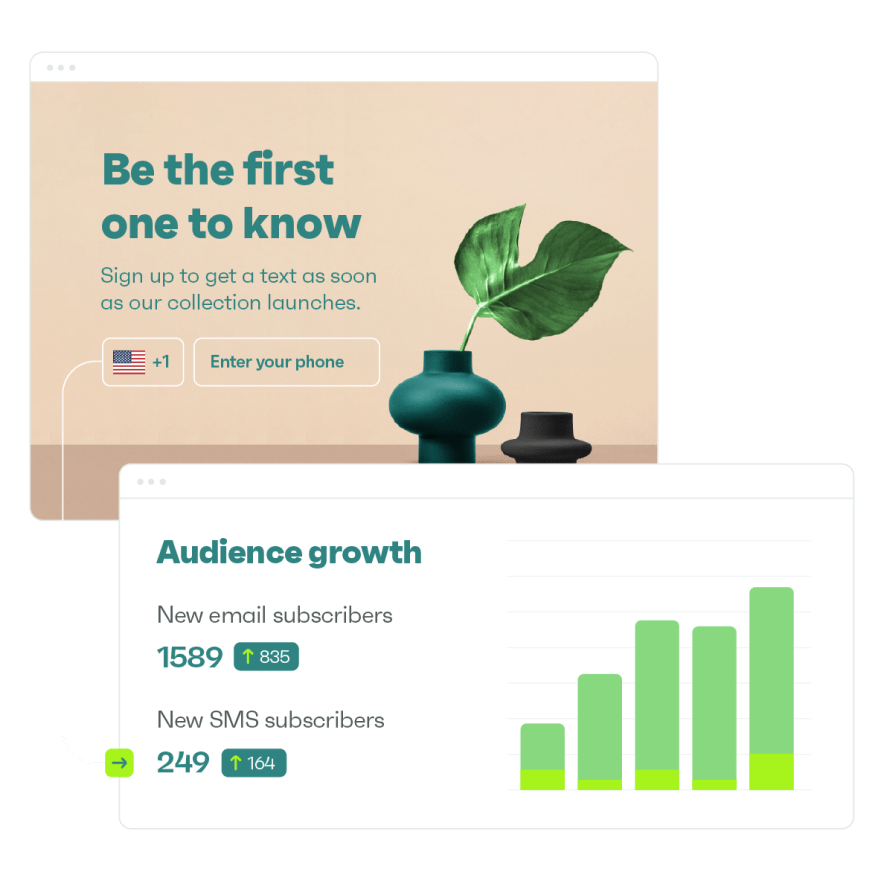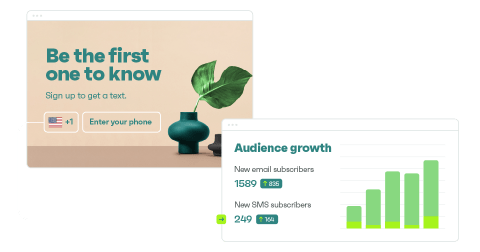Drive sales on autopilot with ecommerce-focused features
See FeaturesThe definitive guide to dynamic emails for 2024
When it comes to marketing channels and platforms that brands can use to communicate with their customers, the numbers are only increasing by the day. Among the many options available, the one channel that continues to deliver the best ROI is email.
But it’s no longer as simple as sending an email and getting the response you want from customers.
According to recent data, the number of emails sent and received per day has hit a whopping 347.3 billion and it’s only increasing by the minute. This is exactly why brands now need to focus more on customer engagement than only running promotions.
This is where personalization comes in — and dynamic emails are the way to go.
In this article, we’re going to talk all about what dynamic emails are, why they are important, the different types of dynamic content in emails, how to set them up, and examples from real brands!
What is a dynamic email?
A dynamic email is one that allows brands to personalize specific parts of an email when sent to different audience groups. These sections of the email are adapted based on the data brands have about customers — age, gender, items in the wish list, abandoned carts, previously purchased products, purchase behavior and similar.
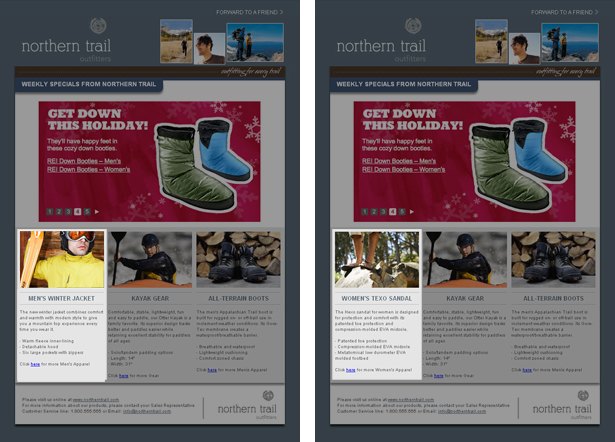
The part or the element you personalize can vary based on your business objective — email subject line, text, visuals, product collections, calls to action.
But what if you don’t have data on a subscriber or customer yet? In that case, the standard email you set goes out to the segment with the same content and visuals.
What are the benefits of dynamic emails?
If you’re wondering why you need to put in the extra work to gather customer data when you can send common promotional emails, let’s look over the benefits of dynamic emails to put things into perspective:
1. Enhance customer experience
According to surveys, 68% of consumers are willing to pay more for products and services if a brand is known for offering a good customer experience.
But this is not restricted to how quickly you respond to their queries on live chat or social media. It’s also about what you do to stand out among the increasing competition.
This is where dynamic emails come in: to help you personalize at scale and show how much your brand cares about your customers’ individual interests and intent.
2. Increase customer engagement
As consumers, we receive thousands of promotional messages from brands across all channels. But how many of them do we really read?
Studies have found that consumers don’t mind deleting emails before reading. And of the 35% of emails that they don’t open simply remain unread. This can be attributed to the increasing number of messages consumers receive and the lack of personalization that makes them more promotional than value-driven.
Dynamic emails help you tailor the communication based on individual preferences and interests, which immediately hooks the consumer’s attention.
Think of how a one-to-one conversation is more engaging than a one-to-many.
3. Saves you time
Traditionally, marketers would have to manually work on emails while setting up campaigns. They would spend hours creating variations of static messages, subject lines, calls to action, and curating product collections to display.
Dynamic emails only require good email marketing software and setting up the parts of the email that need to be personalized. The tool then automatically populates the sections based on the data provided.
4. Send relevant emails to relevant people
Dynamic emails enable your brand to send tailored, relevant emails to the end-consumer as it nudges you to focus on segmentation.
So instead of the usual promotions, deals and discounts you want them to notice, you get to add in content that is more likely to interest them.
For instance, sending discounts on baby products to someone who is single and doesn’t have a baby will only get you an unsubscribe. Even worse, they might mark your email as spam!
5. Improve email click-through rates
The average email click through rate is a mere 2.91% across all industries today.
Again, the reasons come back to increased competition and the lack of personalization in what gets presented to the consumer.
Since dynamic emails focus on what drives the individual consumer’s purchase decisions, they also receive a much higher click through rate across campaigns.
The simple trust is that even the smallest personalization can impact your click-through rates. Omnisend research shows that, in 2022, the simple automated welcome email had a 5.32% click-through rate, which is nearly double the average email click-through rate.
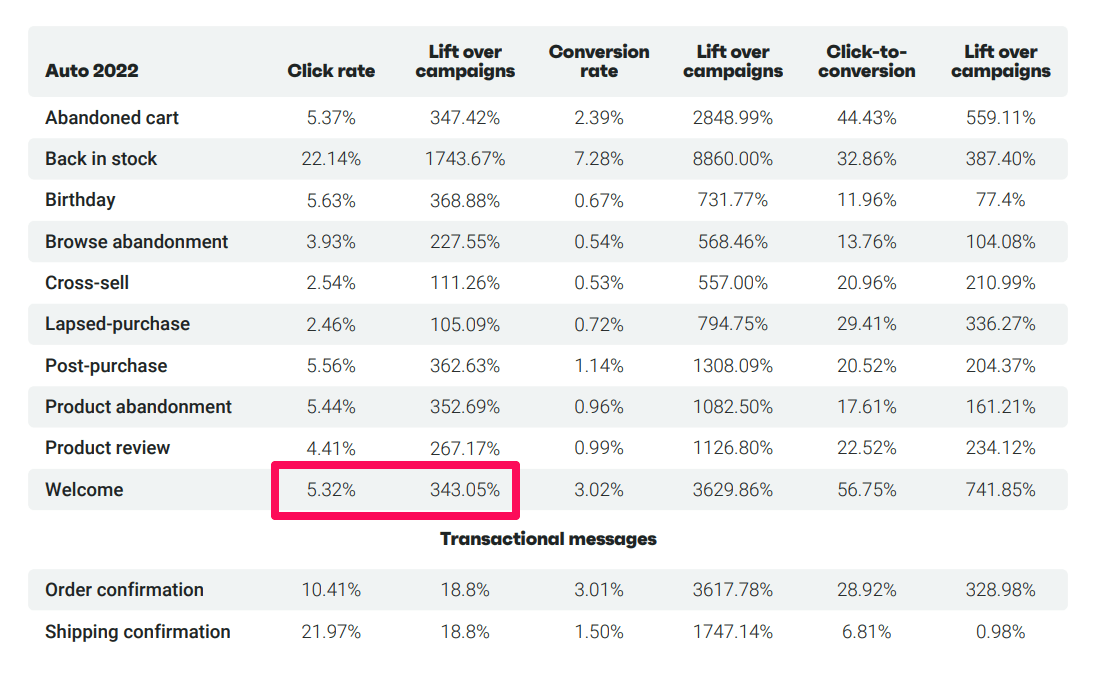
And the only things that are personalized there are the name and the timing — it goes out after a person subscribes to your newsletter for the first time.
For dynamic campaign emails, the process is equally as uncomplicated, and the results equally as promising.
6. Increase your sales
With increased engagement and click through rates, dynamic emails are also able to drive higher sales for brands.
Once you get a consumer to click through the email to your website, it opens up many doors of opportunity to sell. From recommending more products to highlighting more discounts, time-sensitive deals and more, you can jump straight into action to get them to convert.
Pro tip: If you’re promoting a specific collection of products or deals in your dynamic emails, ensure your call to action is also tailored to lead the consumer to that exact page. Hard and irrelevant landings can cause a high bounce rate.
How to create dynamic emails (step by step)
1. Choose an email service provider
To get started with dynamic emails, you need to choose the best email service provider.
From its ability to easily integrate with your choice of CMS, marketing and sales solutions, CRMs, ERPs and other tools — streamlining and segmenting data, enabling automations and offering an easy to use email builder — Omnisend is a leading choice amongst businesses for sending dynamic emails.
Some of the key features of the email builder include:
- Customization to include brand assets (logo, colors, fonts, social links)
- No-code, customizable email templates
- Automatic syncing of product data from your online store
- Unique discount codes that are easy to set up
- Personalized product recommendations
- A/B tests for different audience segments
2. Build your email list
No amount of personalization will work unless you have your customer’s permission to send them emails.
That’s why the very next step is to build your email list in a strategic way.
This may include thinking about a customer’s journey right from the point they discover your brand on social media or through ads and land on your website, up until they make a purchase from you.
A good email service provider like Omnisend will equip you with all the tools you need to grow an email list.
This helps you turn store visitors into subscribers in no time by using:
- Landing pages: Set up custom landing pages to promote specific product collections, sales, deals and discounts
- Popups: Set up popup windows based on triggers like exit intent, on-site activity, time spent on page and other parameters to capture visitor attention with a compelling message or offer
- Wheel of fortune: Set up engaging popups by using gamification that nudges visitors to share email addresses in lieu of winning rewards
- Other signup forms: Use embedded forms or back-in-stock notifications that you can use to grow your list and alert customers when products are back in stock so they can be the first to buy
Additionally, you can grow your email list using the following strategies:
- Social media marketing and advertising: Get your social media audience to subscribe to your email list to receive regular updates or get exclusive offers
- Search advertising: Similarly, capture audience attention during the discovery phase by promoting your email subscription to get exclusive discounts
- Leverage other channels: If you have a list of customers on SMS, WhatsApp, web push and other channels, encourage them to subscribe to emails by highlighting what is different
Pro tip: As you build your email list, remember to request customer preferences on how often they want to hear from you and what type of content they would like to receive.
3. Collect data about customers
Growing an email list will get you the permission you need to send marketing messages to customers. But unless you know more about them, you won’t be able to tap into the power of dynamic emails.
This is where you should have a data collection strategy in place and it should include:
- Contact & other relevant information: your first priority is to get reliable contact information, like email addresses and phone numbers, but also other important data like birthdates (for birthday emails) or city, gender, etc. for more personalized messages
- Site tracking: Every time an online shopper visits your website, you get to know what pages they visit, how long their browsing session lasted and the products they liked. But of course, with cookies phasing out, you will need to use other ways and get permission to capture this data.
- Transaction data: Look into your order analytics to identify what products get purchased the most, which discount code ensures checkout completion, which payment modes get used the most, your average order value and similar data.
- Surveys and feedback: Get first-hand consumer insights and inputs by setting up surveys for your customers. But remember to ask extremely targeted questions in order to derive actionables.
- Social media: Deep dive into your social analytics to identify similarities and patterns between your followers. This can uncover insights like active demographics and interests.
- Marketing analytics: Take a look at all the channels you’re using for customer communication across their lifecycle. Identify which channels tend to be preferred at what stage, the value they bring to your sales funnel, how consumers engage with them and so on.
4. Group your email subscribers
Once you have the data in place, the next step is to group consumers based on similar interests and characteristics. The way you segment your customer data can make or break the success of your dynamic emails.
- Demographic: age, gender, location, purchase power, education, etc
- Psychographic: values, beliefs, goals, interests and desire
- Preferences: type of content they want to receive
- Behavioral: website activity, previous purchases, type of engagement, etc
You can have the above customer segments in place with a solution like Omnisend that allows you to group consumers in real time based on the following:
- Channel and subscription status: This rule allows you to segment consumers by their subscription status to promotional messages from your brand.
- Customer properties: This includes segmenting customers on the basis of the data they have shared with your brand. From name, email address, gender, phone number, address, customer lifecycle state and more, this data can be collected via Omnisend, third-party signup forms, or manually imported.
- Engagement: This allows you to segment customers based on their activity, including opens and clicks on the previous messages sent and web tracking. Omnisend lets you further filter these based on actions such as receiving a message, opening a message, clicking on a message and viewing a page.
- Shopping behavior: This allows customer segmentation based on their shopping behavior with your brand, and includes their purchase pattern, products purchased, the number of products bought and similar.
- Web activity: This lets you segment customers based on how they interact with your online store. For instance, people who viewed your website, people who visited more than two pages or people who visited a specific collection page.
- Custom events: This Omnisend feature allows you to segment customers based on the custom events you create or upload. These events could cover aspects like whether the customer has posted a review, asked for customer support on purchases, returned items and similar.
5. Create dynamic email content
Adding dynamic content to your emails is easy when you use the Omnisend drag and drop email builder. All you need to do is choose the content you want to display (blocks) and select the audience segment you want to send it to.
When you click on a content block, the email builder will open a sidebar that displays all the targeting options. This is where you can define who sees your dynamic email content.


For example, if you want to filter the content of the dynamic email based on the Country, you will need to enter the Country’s name into the input field.

You can also use the above conditions and filtering on your customer segments to exclude subscribers from receiving dynamic emails.
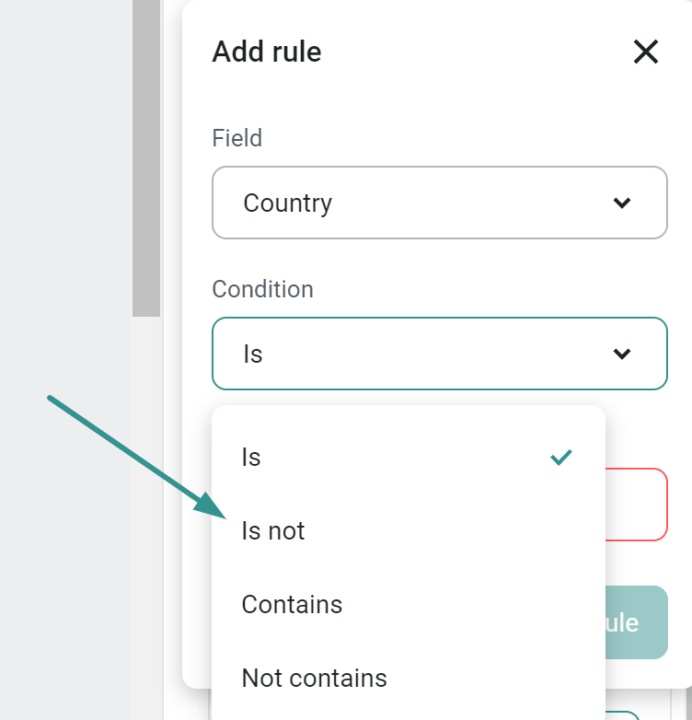
Pro tip: Before you start adding contact blocks, we recommend setting up a dynamic emails template. You can import a custom HTML dynamic email template or use one of our pre-existing, customizable templates.
Best dynamic email examples
Before you get into setting up a campaign with dynamic email content, let’s take a look at how brands are leveraging this capability:
1. Brooklinen
A luxury brand known for its collection of bed sheets, pillows, comforters and blankets, Brooklinen uses dynamic emails to introduce subscribers to new products.
They use their previously purchased products as the variable to send personalized product recommendations from other collections. This helps them improve product discovery and increase repeat purchases.

2. Nike
A popular sportswear brand for men and women, Nike knows that remaining relevant to customer interest is the only way to keep their community intact.
They have segmented their email list on the basis of various parameters like intent and demographics. With the help of dynamic emails, they’re able to swap out the hero visuals as well as the product collections in their emails.

3. Too Faced
A global beauty and cosmetics brand, Too Faced uses dynamic emails for abandoned cart recovery.
While the additional discount on the cart total remains the same for all, they use dynamic content fields to populate the product names and images of the items left behind to help with recall. This instantly helps bring back buyers to complete the purchase!
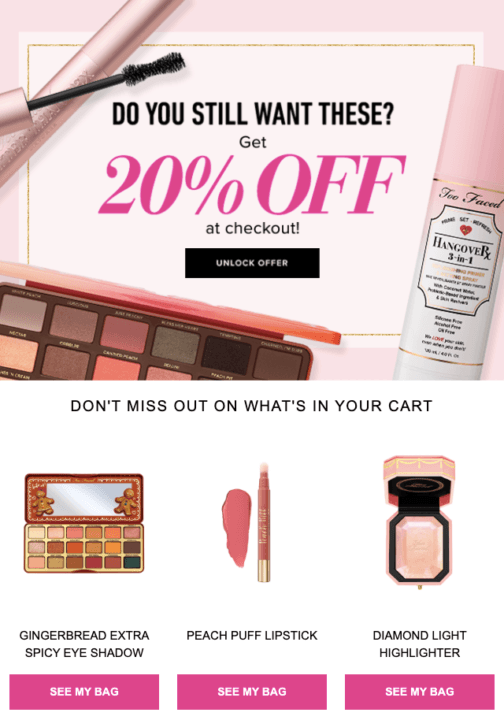
4. Sephora
Another beauty and cosmetics brand that uses dynamic emails in an innovative way, is Sephora. They have made dynamic emails a part of their communication with those who sign up for their loyalty program.
Apart from sending the usual welcome message along with a recap of the benefits their program offers, they also populate the best seller product recommendations based on where a buyer subscribed from and their previous interactions.

5. Keds
A footwear brand known for its comfortable shoes for all age groups, Keds uses dynamic emails in their product restock campaigns.
They use the emails to notify subscribers about product availability, but also introduce them to similar bestsellers from their store. This helps them bring back interested shoppers even if they may have made the initial purchase from another store, and boost product discovery on the site.

6. Lancome
A luxury cosmetics brand, Lancome understands the importance of personalized emails to high-end shoppers. They use dynamic emails in their replenishment reminder campaigns.
Based on what the customer is using, they send a quick reminder and some product recommendations that are bound to further improve their experience. This helps them get more products discovered and also increase their average order values.
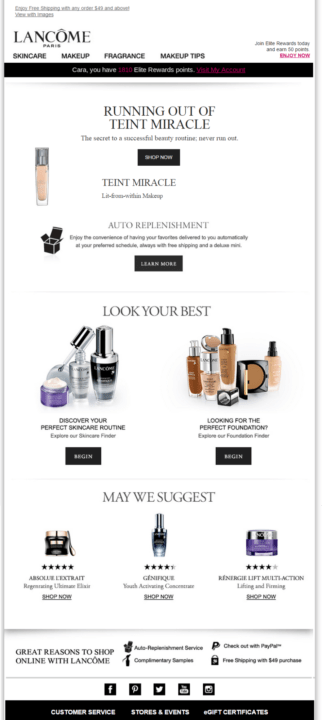
7. Huckberry
Another fantastic example of dynamic email content is that from Huckberry, a brand known for its outdoor gear for men.
They use dynamic content in emails to turn their order confirmation message into an opportunity to sell more. By including trending gear from collections related to those that the customer has bought from, they are able to reconvert the buyer, driving a repeat purchase faster.

You need to set up your dynamic emails today
Irrespective of the different target audience segments your brands sell to, personalization is a common consumer expectation.
In times when inboxes are becoming too cluttered with promotions and broadcast emails, be the one the brand that stands out and delivers personalized messages to consumers.
It’s not about just sending another email campaign; it’s about the experience that email is able to deliver.
With eCommerce marketing solutions like Omnisend, you can tailor your email fields to bring in dynamic content relevant to individual interests and intent easily. By integrating with your eCommerce store, CRM and other marketing apps, it is able to pull in consumer data that can help you make emails more personalized.
Ready to send your first dynamic email campaign?
quick links
related features
No fluff, no spam, no corporate filler. Just a friendly letter, twice a month.
